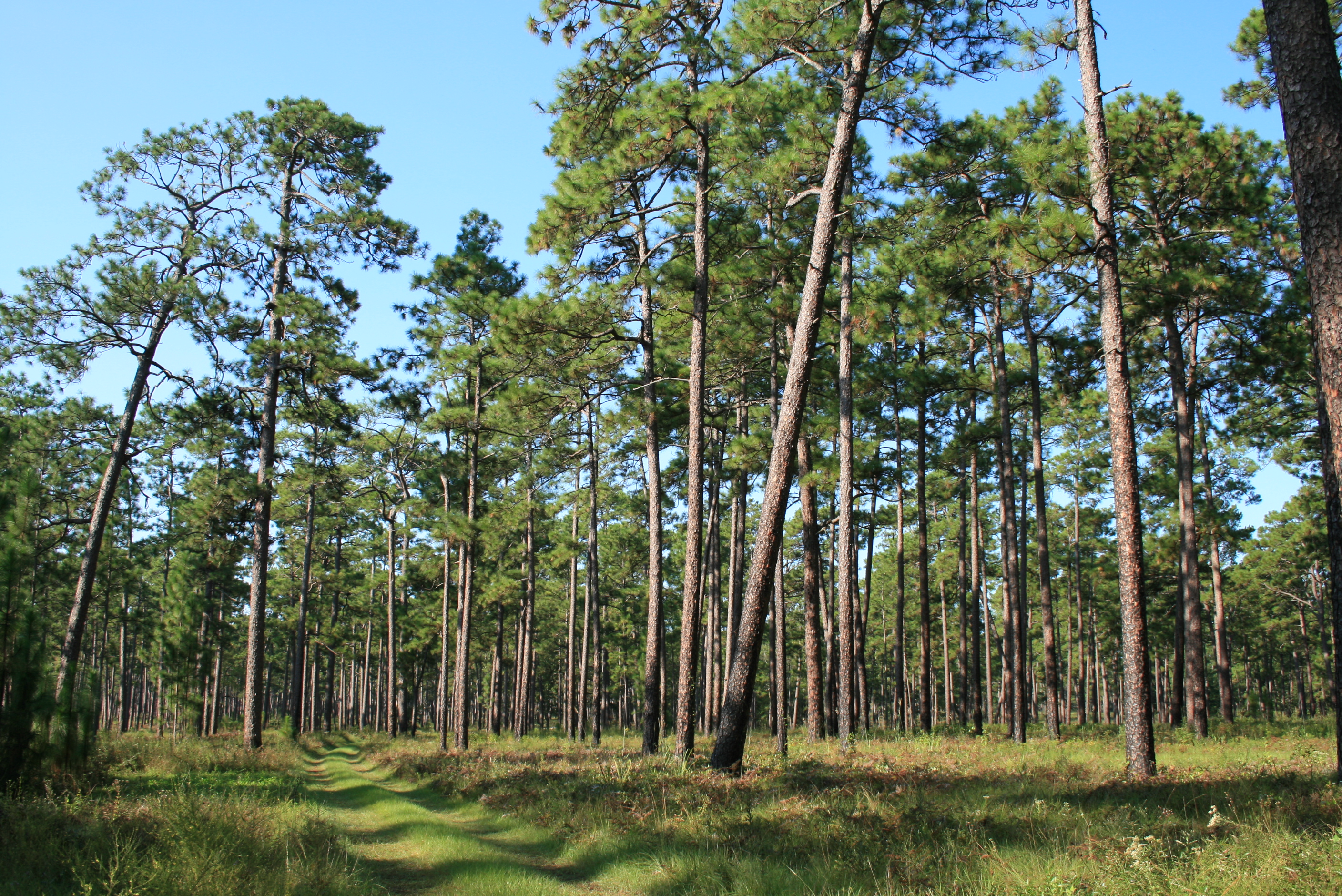Considerations for Planting Longleaf Pine

Species selection is an important component of timber production. Silvicultural advancements associated with the development of containerized seedlings have increased the viability of longleaf pine (Pinus palustris (Mill.)) in artificial reforestation efforts.
Planting longleaf provides several biological advantages compared to other southern pines, including resistance to drought, wind damage, and fire. Longleaf pines also have long needles, straight trunks, and greater self-pruning potential, making them good for pole production and the pine straw industry.

Figure 1.Longleaf pine seedlings in the grass stage. Note the lack of aboveground stems.
While these factors have helped offset the greater length of time needed for longleaf to reach merchantability compared to other pine species, perhaps the most influential factor for many landowners is the opportunity to obtain cost-share funds. Many federal and state agencies offer financial assistance to help offset costs associated with establishing and maintaining longleaf.
These cost-share programs have benefited restoration efforts within longleaf’s historical range. However, cost-share availability is not the only factor to consider when selecting a species. Landowners should understand basic longleaf biology and the factors that contribute to successful management. This publication identifies important factors to consider before planting longleaf pine.
Longleaf Biology
Longleaf pine differs from loblolly (P. taeda (L.)) and slash (P. elliottii (Engelm.)) pine in its early-growth strategy. Instead of immediately initiating height growth, longleaf seedlings remain stemless in a developmental stage known as the grass stage (Figure 1). While in the grass stage, longleaf allocates the majority of its resources to root development rather than height growth. Longleaf seedlings can remain in the grass stage for up to 15 years.
Height growth, also known as bolting, typically begins once seedlings develop a 1-inch root collar (Figure 2). The length of the grass stage is influenced primarily by competition from surrounding vegetation for light, soil moisture, and nutrients. Longleaf requires high-light environments to survive and develop. Consequently, reducing competition is key to shortening the grass stage. Growth rates following the grass stage are comparable to the other southern pines.

Figure 2. Longleaf pine seedlings exiting the grass stage
Site Considerations
Longleaf can be grown across a wide range of soils. However, relative to the other southern pine species, it is superior only on excessively drained, sandy sites. On such dry sites, the natural drought tolerance of longleaf allows it to survive and maintain height growth better than lesser drought-adapted pines such as loblolly and slash. However, landowners should recognize that longleaf growth is not maximized on sandy soils. Growing longleaf on more productive soils is possible but may require more intensive vegetation management to bring seedlings through the grass stage.
Market Availability
Market awareness is a key consideration when growing forest products. Many of the advantages of growing longleaf are derived from pine straw and pole markets. Pine straw markets are generally strongest near large population centers. In contrast, pole markets are less dependent on population but do usually benefit from being near pole mills.
Longleaf is capable of producing high-quality sawtimber. Longleaf timber typically weighs more than loblolly or slash pine, making it slightly more valuable on a tonnage basis. However, due to the length of the grass stage, growing longleaf will extend the timber rotation by 5–10 years. Thus, loblolly and slash pine are widely considered better options for sawtimber production.
Competition Control
Competition control is critical for bringing longleaf through the grass stage. Historically, frequent, low-intensity fire helped longleaf become the dominant tree species throughout much of the Coastal Plain. Longleaf pine seedlings are highly resistant to fire once their root collar reaches 0.5 inch in diameter. The occurrence of frequent, low-intensity surface fire was important for not only controlling competition from less fire-adapted species but also for controlling brown spot needle blight. Consequently, prescribed fire is often recommended every 2 to 3 years once seedlings have developed an adequate root collar.
Unfortunately, many liability factors, including proximity to major roadways, poultry operations, hospitals, and residential areas, can inhibit the use of prescribed fire as a silvicultural tool. Landowners who use prescribed fire can, be held liable for damages from a prescribed fire. Fortunately, prescribed fire is not the only option for competition control. Herbicides are effective at controlling a wide range of woody and herbaceous species. However, longleaf is more susceptible to damage from herbicides commonly used to promote loblolly and slash pine production. Herbicides will not be as effective as prescribed fire to treat brown spot needle blight.
Invasive Species
Invasive species have changed the function of many of our native forests. Nowhere in Mississippi is this more relevant than in the historical range of longleaf, where many invasive species have become established. Two of the more problematic species are cogongrass (Imperata cylindrica (L.)) and Japanese climbing fern (Lygodium japonicum (Thunb.)).
Cogongrass forms a dense thatch (dead vegetation layer) on top of the ground during the winter. This layer can increase fire intensity and often results in the death of longleaf seedlings. In addition, the pyric (fire dependant) nature of longleaf pine serves to propagate cogongrass instead of controlling it.
Japanese climbing fern increases prescribed fire risk by providing a substrate for fire to transition from the forest floor to the canopy. Longleaf pine is resistant to surface fire, but, like all conifers, can be killed if fire transitions into the crown. Landowners can remedy this problem by treating invasive species on their own property.
However, continual colonization from invasive species established on neighboring properties can create a reoccurring problem in longleaf management. As such, landowners should assess the invasive species population not only on their own property but also on surrounding properties before planting longleaf pine.
Conclusions
Growing longleaf pine can be a rewarding and lucrative practice for private landowners in areas with pole and pine straw markets. The availability of cost-share opportunities makes it an even more attractive option for landowners looking to reestablish forests in South Mississippi. Nevertheless, landowners should recognize that growing longleaf requires a longer, more expensive commitment to active management than loblolly or slash pine. In addition, the link between longleaf management and prescribed fire creates certain logistical limitations for managing longleaf. As such, we encourage landowners to consider all of the factors discussed in this publication before planting longleaf pine.
References
Boyer, W. D. 1990. Growing season burns for control of hardwoods in longleaf pine stands (Research paper SO-256). U.S. Department of Agriculture, Forest Service, Southern Forest Experiment Station, New Orleans, LA.
Burns, R. M., & Honkala, B. H. 1990. Silvics of North America: Volume 1. Conifers. In Agriculture Handbook 654. U.S. Department of Agriculture, Forest Service.
Self, A. B. 2022a. Planting southern pines: A guide to species selection and planting techniques. Mississippi State University Extension Service Publication 1776.
Self, A.B. 2022b. Herbicide options for management of longleaf pine. Mississippi State University Extension Publication 3405.
Self, A.B. 2020. Growing pine needles and timber. Mississippi State University Extension Publication 3129.
The information given here is for educational purposes only. References to commercial products, trade names, or suppliers are made with the understanding that no endorsement is implied and that no discrimination against other products or suppliers is intended.
Publication 3300 (POD-08-23)
Revised by Brady Self, PhD, Associate Extension Professor, Forestry, from an earlier version by John Willis.
The Mississippi State University Extension Service is working to ensure all web content is accessible to all users. If you need assistance accessing any of our content, please email the webteam or call 662-325-2262.





